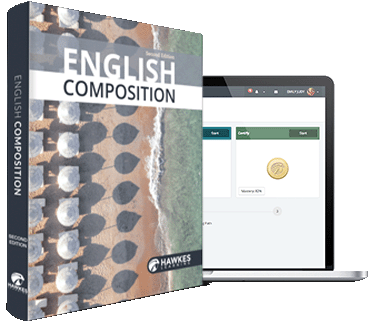
English Composition, 2nd Edition
Overview
With emphasis on effective communication in a changing world, English Composition takes a contextualized approach to writing instruction for students of all disciplines, experiences, and backgrounds with features and updates including:
- Thought-provoking writing samples & prompts
- Reflection questions
- Application exercises
- Group activities
- Real-world applications
- Comprehensive chapter review lessons
- Chapter projects
- Additional/revamped topics and examples
- Updated research content including APA 7th Edition guidelines
The second edition also includes seven brand new lessons:
- Analyzing and Interpreting Literature
- Responding Critically to Literature
- Basics of Information Literacy
- Professional Writing
- Multimedia Projects
- Thinking Critically about Pop Culture
- Technical Writing
Products
Formats: Software, Textbook, eBook
| Product | ISBN |
|---|---|
| Software + eBook | 978-1-64277-457-3 |
| Textbook + Software + eBook | 978-1-64277-459-7 |
Table of Contents
- Chapter 1: Why We Write
- 1.1 Writing Situations and Purposes
- 1.2 Writing to Summarize
- 1.3 Writing to Respond
- 1.4 Writing to Propose
- 1.5 Writing to Discuss
- 1.6 Writing to Describe
- 1.7 Writing to Argue
- 1.8 Writing to Analyze
- 1.9 Writing to Evaluate
- Chapter 1 Review
- Chapter 2: Modes of Writing
- 2.1 Descriptive Writing
- 2.2 Narrative Writing
- 2.3 Expository Writing
- 2.4 Persuasive Writing
- Chapter 2 Review
- Chapter 3: The Writing Process
- 3.1 Pre-Writing
- 3.2 Drafting
- 3.3 Revising
- 3.4 Peer Review
- 3.5 Editing
- 3.6 The Final Draft
- Chapter 3 Review
- Chapter 4: Parts of the Essay
- 4.1 Rhetorical Essay Structures
- 4.2 The Introduction
- 4.3 Thesis and Purpose Statements
- 4.4 Body Paragraphs
- 4.5 Transitions
- 4.6 The Conclusion
- Chapter 4 Review
- Chapter 5: Reading & Rhetoric
- 5.1 Taking Notes and Annotating Texts
- 5.2 Identifying the Main Idea and Supporting Details
- 5.3 Identifying Organizational Patterns
- 5.4 Understanding Purpose, Audience, and Tone
- 5.5 Recognizing Rhetorical Appeals
- 5.6 Analyzing Rhetoric through Word Choice
- 5.7 Understanding the Basics of Logic
- 5.8 Recognizing Logical Fallacies
- 5.9 Evaluating Evidence
- 5.10 Analyzing Rhetoric through Visuals
- 5.11 Analyzing and Interpreting Literature
- Chapter 5 Review
- Chapter 6: Writing & Rhetoric
- 6.1 Understanding an Argument
- 6.2 Considering Purpose and Audience
- 6.3 Recognizing Constraints
- 6.4 Employing Rhetorical Appeals
- 6.5 Using Consistent Tone
- 6.6 Choosing the Right Words
- 6.7 Using Word and Sentence Variety
- 6.8 Polishing an Argument
- 6.9 Responding Critically to Literature
- Chapter 6 Review
- Chapter 7: Research
- 7.1 Basics of Information Literacy
- 7.2 Understanding the Research Paper
- 7.3 Planning and Tracking Your Research
- 7.4 Identifying Types of Sources
- 7.5 Evaluating the Credibility of Sources
- 7.6 Understanding and Avoiding Plagiarism
- 7.7 Integrating Sources into Your Writing
- 7.8 The Annotated Bibliography
- 7.9 Basics of MLA Style
- 7.10 Basics of APA Style
- 7.11 Basics of CMS
- 7.12 Basics of CSE Style
- Chapter 7 Review
- Chapter 8: Writing Beyond the English Classroom
- 8.1 Writing across the Disciplines
- 8.2 Visual and Digital Arguments
- 8.3 Oral Presentations
- 8.4 Etiquette in Social Media
- 8.5 Technical Writing
- 8.6 Professional Writing
- 8.7 Multimedia Projects
- 8.8 Thinking Critically about Pop Culture
- Chapter 8 Review
- Chapter 9: Basics of Grammar and Mechanics
- 9.1 Parts of Speech
- 9.2 The Characteristics of a Sentence
- 9.3 Using Commas
- 9.4 Using Semicolons and Colons
- 9.5 Using Quotation Marks, Parentheses, and Brackets
- Chapter 9 Review
- Chapter 10: Grammatical Sentences
- 10.1 Common Sentence Errors
- 10.2 Using Consistent Subjects and Verbs
- 10.3 Using Consistent Pronouns and Antecedents
- 10.4 Using Correct Pronoun Reference and Case
- 10.5 Correcting Misplaced and Dangling Modifiers
- 10.6 Using Active and Passive Voice
- 10.7 Maintaining Consistency in Tense and Person
- 10.8 Using Parallelism, Coordination, and Subordination
- 10.9 Proofreading Sentences for Grammar
- Chapter 10 Review